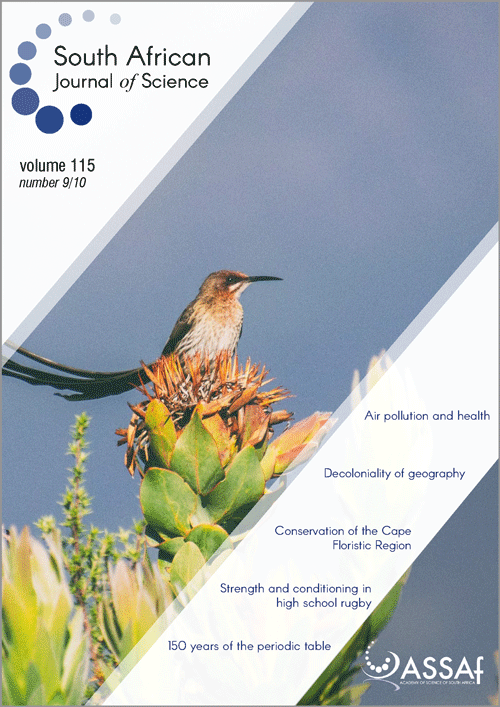Rainfall and river flow trends for the Western Cape Province, South Africa
DOI:
https://doi.org/10.17159/sajs.2019/6028Keywords:
Mann–Kendall, water resource management, decreasing trends, spatio-temporal distributionAbstract
Climate change has the potential to alter the spatio-temporal distribution of rainfall, subsequently affecting the supply and demand of water resources. In a water-stressed country such as South Africa, this effect has significant consequences. To this end, we investigated annual and winter rainfall and river flow trends for the Western Cape Province over two periods: 1987–2017 and 1960–2017. Annual rainfall for the most recent 30-year period shows decreasing trends, with the largest magnitude of decrease at the SA Astronomical Observatory rainfall station (-54.38 mm/decade). With the exception of the significant decreasing winter rainfall trend at Langewens (-34.88 mm/decade), the trends vary between stations for the period 1960–2017. For the period 1987–2017, statistically significant decreasing winter trends were found at four of the seven stations, and range from -6.8 mm/decade at Cape Columbine to -34.88 mm/decade at Langewens. Similarly, the magnitudes of decreasing winter river flow at Bree@Ceres and Berg@Franschoek are greater for the more recent 30-year period than for 1960–2017. Correlation coefficients for Vilij@Voeliv rainfall and four river flow stations Berg@Franschoek, Bree@Ceres, Wit River@Drosterkloof and Little Berg@Nieuwkloof) are stronger for shorter periods (i.e. 1987–2017 and 2007–2017) than that for the longer period, 1960–2017. The Intergovernmental Panel on Climate Change emphasises the importance of studies to assist with model prediction uncertainties. To this end, our study expands the understanding of regional hydrological responses to rainfall change in the water stressed region of the Western Cape Province.
Significance:
- Historical trend analyses provide the basis for future rainfall and river flow projections and also improve our understanding of hydrological responses to rainfall change, which is important for water resource planning and management in light of recent rainfall shortages experienced in the Western Cape region.
- Anthropogenic and natural influences on river systems must be taken into account when assessing the impact of rainfall changes on river flow because these factors ultimately affect water resource management.
- We identified decreasing winter rainfall trends across the Western Cape Province for the most recent three decades.
Published
Issue
Section
License

All articles are published under a Creative Commons Attribution 4.0 International Licence
Copyright is retained by the authors. Readers are welcome to reproduce, share and adapt the content without permission provided the source is attributed.
Disclaimer: The publisher and editors accept no responsibility for statements made by the authors
How to Cite
- Abstract 1934
- PDF 3000
- EPUB 226
- XML 452













.png)